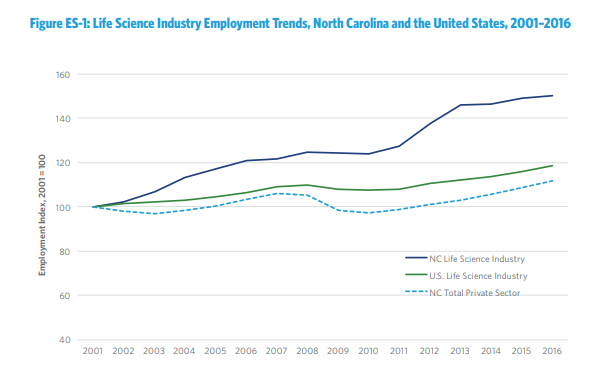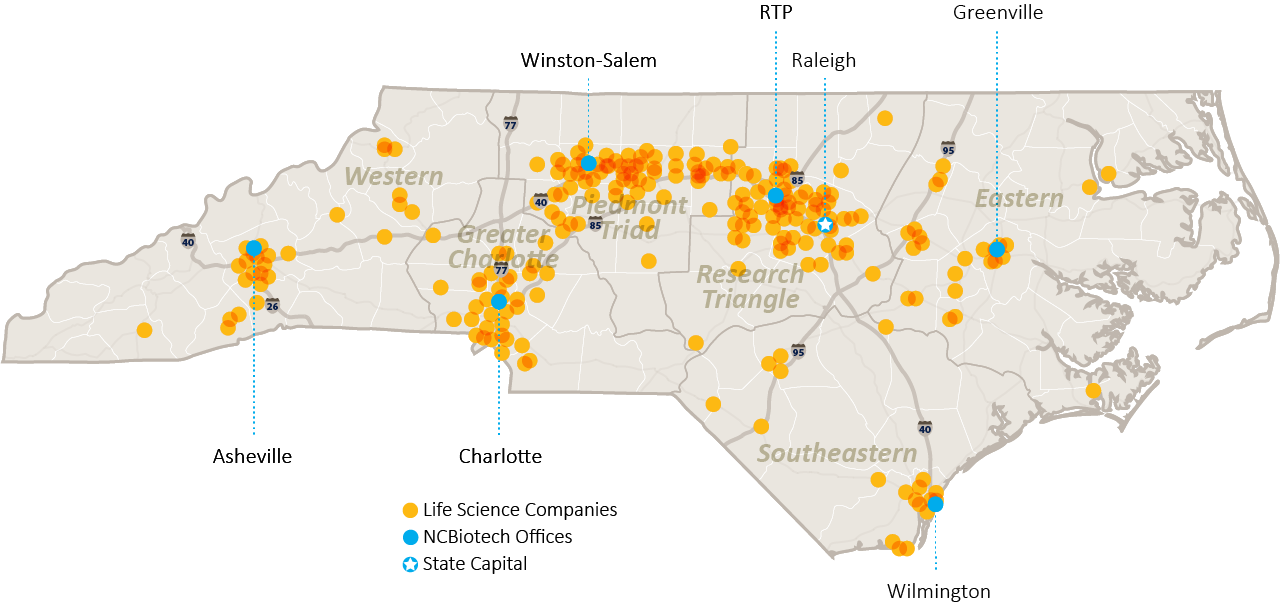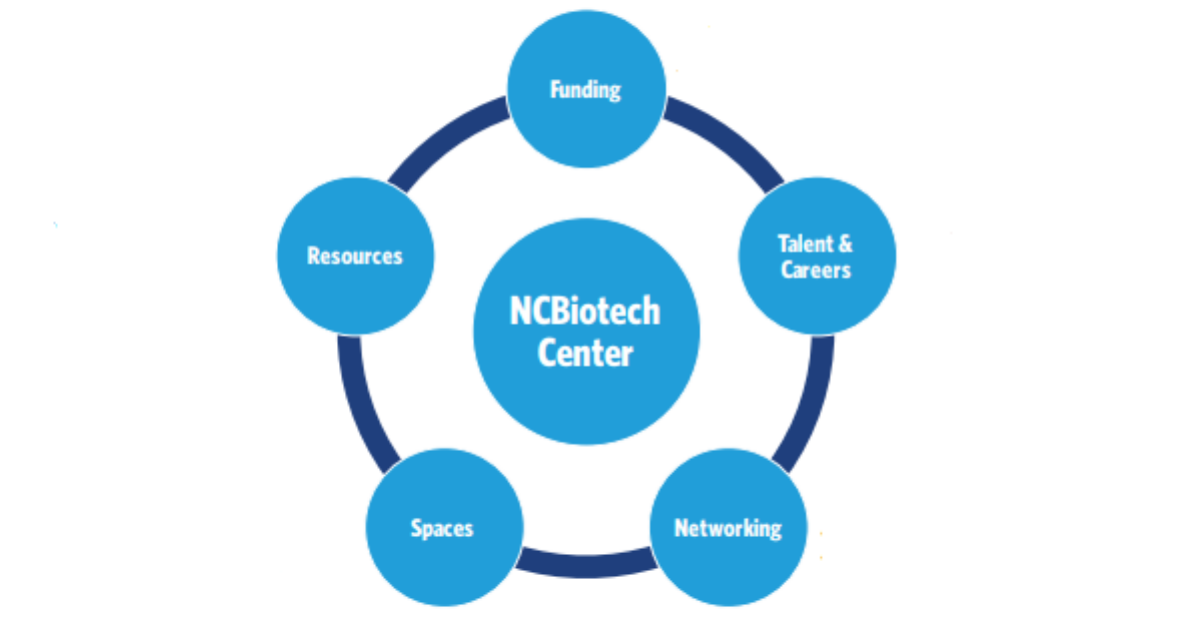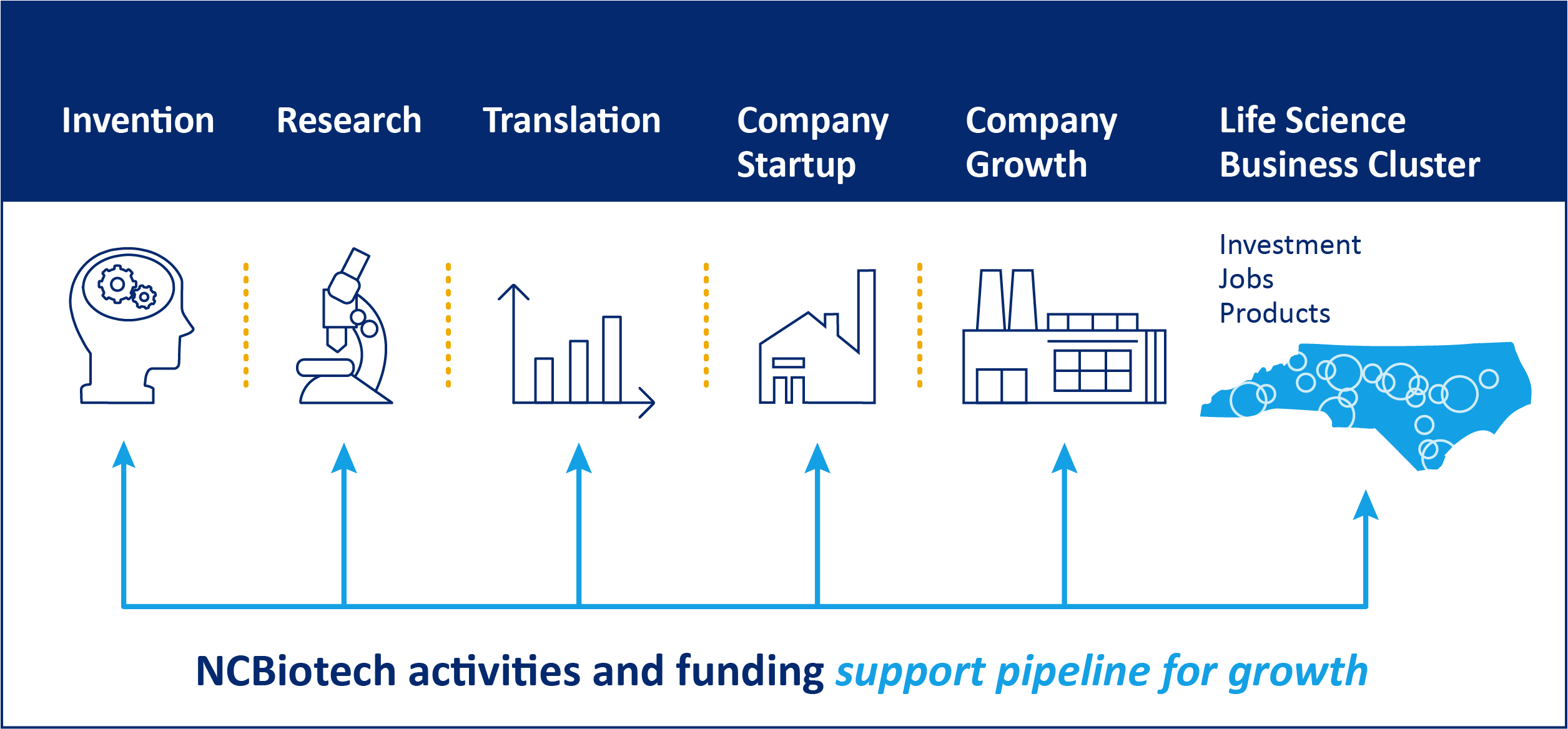Highlights From the 2018 TEConomy Report
The 2018 TEConomy report evaluates North Carolina's life science landscape and maps growth from the past decade.
"2018 Evidence and Opportunity: Impact of Life Sciences in North Carolina" marks the 10th anniversary of our contract with TEConomy Partners. The 2018 report showcases a story of incredible transformation over the last ten years, clearly defining the growth of our life science sector and its contribution to the state's economy.
Here are key takeaways from the report.
A Decade of Economic Impact
Although TEConomy produces an in-depth analysis for NCBiotech every two years, the 2018 report highlights benchmarks from 2008 to 2018. It's clear that NC's life science sector greatly impacts North Carolina's economy.
-
Total jobs supported by the life science sector grew 33% from 2008 to 2018
-
Total economic impact of the sector grew 82% in that same time, from $45.8B to $83.3B
-
The state’s life science sector generated nearly $2.2B in state and local government revenues in 2018, up from $1.4B in 2008

Significant Increase in Life Science Employment
North Carolina’s 50 percent life science employment increase was fourth-highest nationally in the decade and a half through 2016. That compares to a 12 percent growth in the state’s overall private sector since 2001, “and has far exceeded the pace of national (life science) industry growth of nearly 19 percent,” according to the report.

"North Carolina has established one of the nation’s leading life science industry clusters, characterized by steady, long-term growth and establishment of a diverse blend of industry, technology, and market strengths and niches."
2018 TEConomy Report
Three Subsectors Lead the Way
TEConomy cites three major life science “subsectors” in which North Carolina is especially prominent.
The research, testing, and medical labs sector, along with the state’s bioscience-related distribution sector, have enjoyed especially high employment growth in the state. They’ve both outpaced national job growth since 2014.

Drugs and Pharmaceuticals
- #3 in the nation
- generates $56.4 billion in economic activity
- supports 132,507 jobs earning $9.6 billion in labor income
- generates $1.4 billion in state and local government revenues

Research, Testing, and Medical Labs
- #5 in the nation
- generates $13.7 billion in economic activity
- supports 75,232 jobs earning $4.8 billion in labor income
- generates $431 million and state and local revenues

Agricultural Feedstock and Industrial Biosciences
- generates $7.3 billion in economic activity
- supports 14,061 jobs earning $1 billion
- generates $160 million in state and local government revenues
Impact of Biomanufacturing in North Carolina
Biomanufacturing Training Programs Create Jobs Boom
In 2003,17 companies were employing 4,754 people. According to the TEConomy report, those numbers jumped 93 percent by 2018 with at least 25 biomanufacturing companies employing 9,163 people directly.
Industry training programs developed in partnership with NC's community colleges have continued to grow the biomanufacturing talent pipeline. Those workers are creating a wide range of high-value products including biopharmaceuticals, animal health products, food ingredients and industrial products such as enzymes.
NC’s High-value Biomanufacturing Soars Above National Average
The report notes that North Carolina has between four and five times the concentration of high-value biological product manufacturing as the national average.
The 25 companies evaluated for the report had estimated revenues of $9.9 billion and generated nearly $14.2 billion in economic activity for the state.

"The long-term, impressive rise of North Carolina’s life science industry, its broader R&D and innovation ecosystem, and its significant economic impacts can be directly tied, at least in part, to the deliberate, sustained programmatic initiatives and partnerships of NCBiotech."
2018 TEConomy Report
Significance of NCBiotech
The TEConomy report attributes North Carolina’s success in building a top-tier life science economy, “in large part due to the early foresight and consistent dedication of the North Carolina Biotechnology Center," and notes that our strategic investments and role as a statewide connector are prominent contributors to the success of the innovation pipeline in North Carolina.

NCBiotech’s Statewide Development is Effective
NCBiotech’s statewide cluster development activities, emanating from its Research Triangle Park headquarters and regional offices in Asheville, Charlotte, Greenville, Wilmington and Winston-Salem, have proven effective.
“The diversity of North Carolina’s life science industry is not only characterized by its industry subsectors but further by its geographic reach across every region of the state.”
-2018 TEConomy Report

Programs and Initiatives from NCBiotech Accelerate Economic Activity
NCBiotech programs and initiatives, including loans, grants, regional and sector development, business services, special events and job services.
Of the 204 NCBiotech loans given to North Carolina life science companies since 1989, 107 are currently active in some form, employing 2,544 people and generating estimated revenues of $2.5 billion.
That creates $3.8 billion in economic activity statewide, creates or supports 10,390 jobs earning $732 million in labor income, and produces $98.4 million in state and local taxes.

ROI on NCBiotech Quadruples State Investment
“North Carolina receives a strong return on its investment in NCBiotech,” notes the report.
TEConomy estimated the state government gets $60.3 million of the estimated $98.4 million in annual tax generation from NCBiotech portfolio companies, “an amount more than four times greater than the state’s appropriation to NCBiotech of $14.0 million for fiscal year 2018–2019.”
More Information
- Read the full 2018 TEConomy Report
- View our news section for info on what's happening in NC
- Follow us on Twitter, Facebook, and LinkedIn
- Sign up for our newsletter
Photo credits: TEConomy Partners, iStock, Grifols
